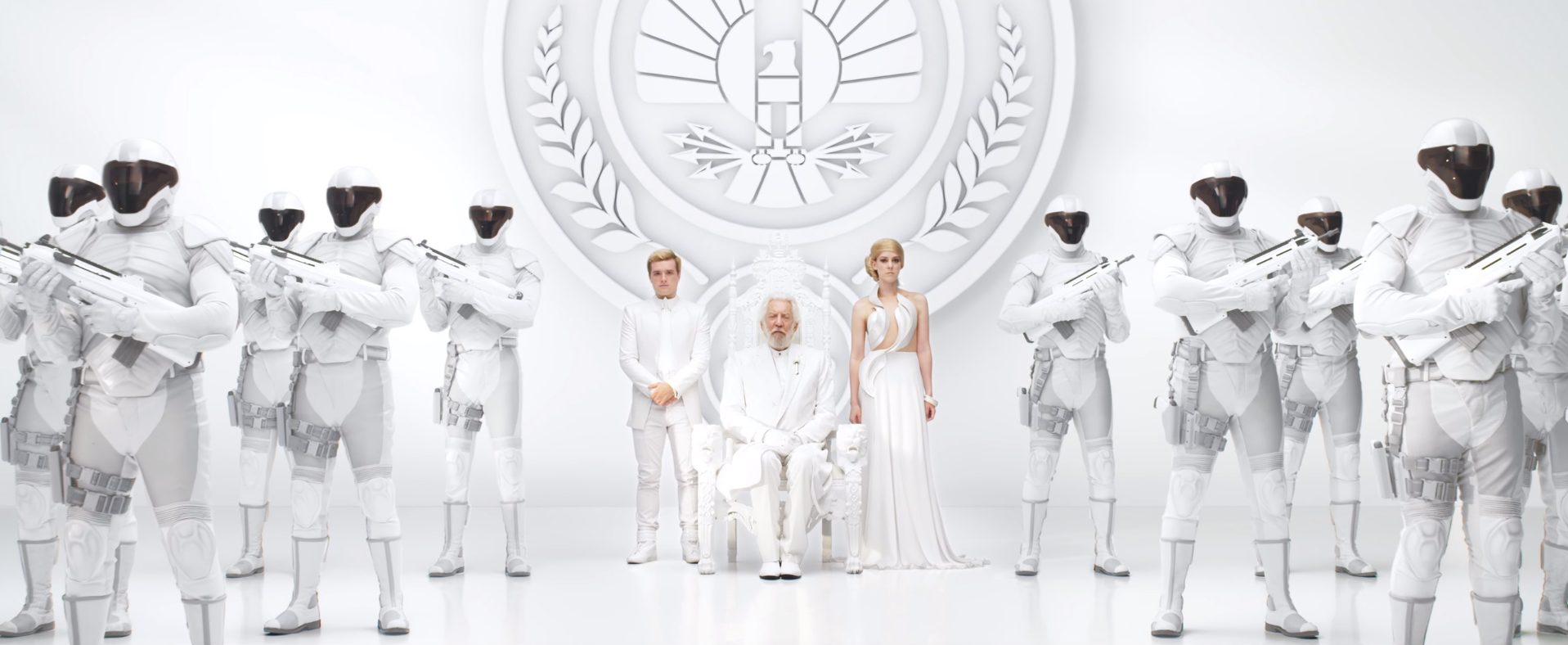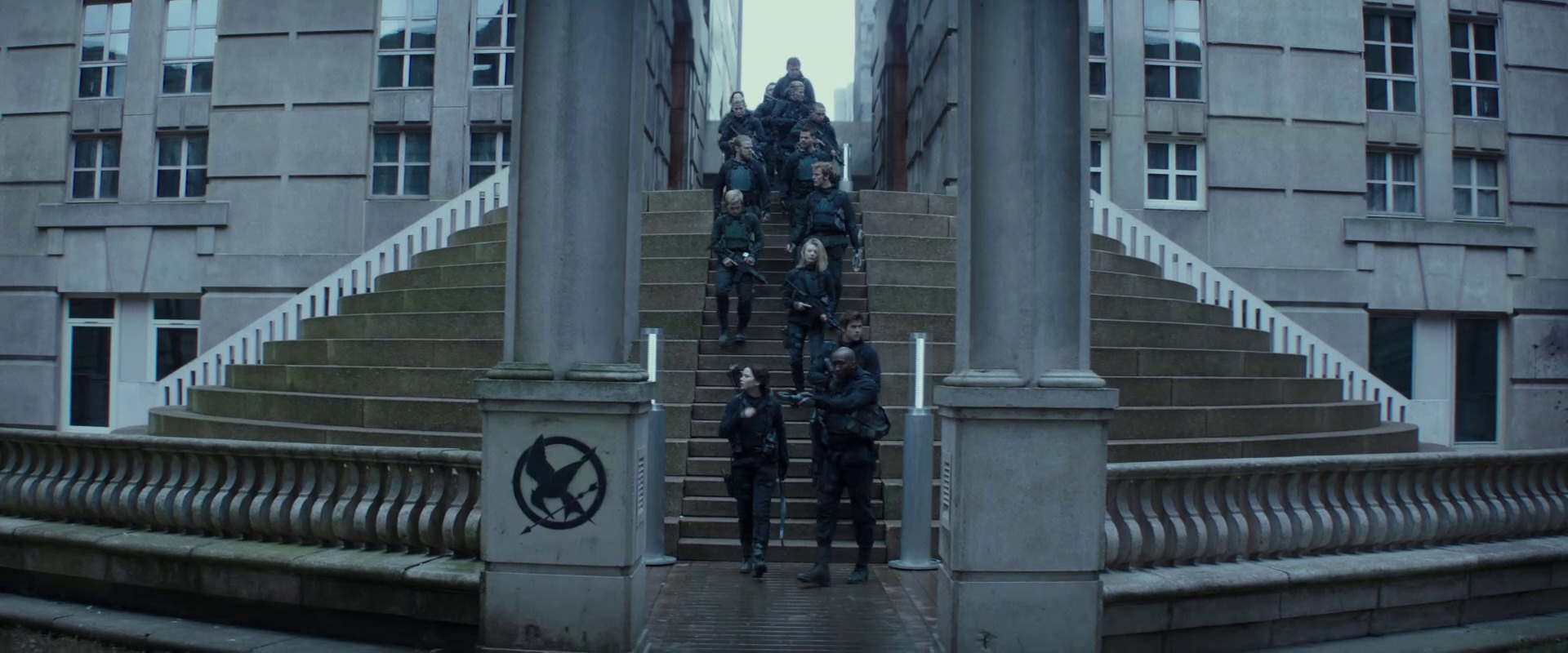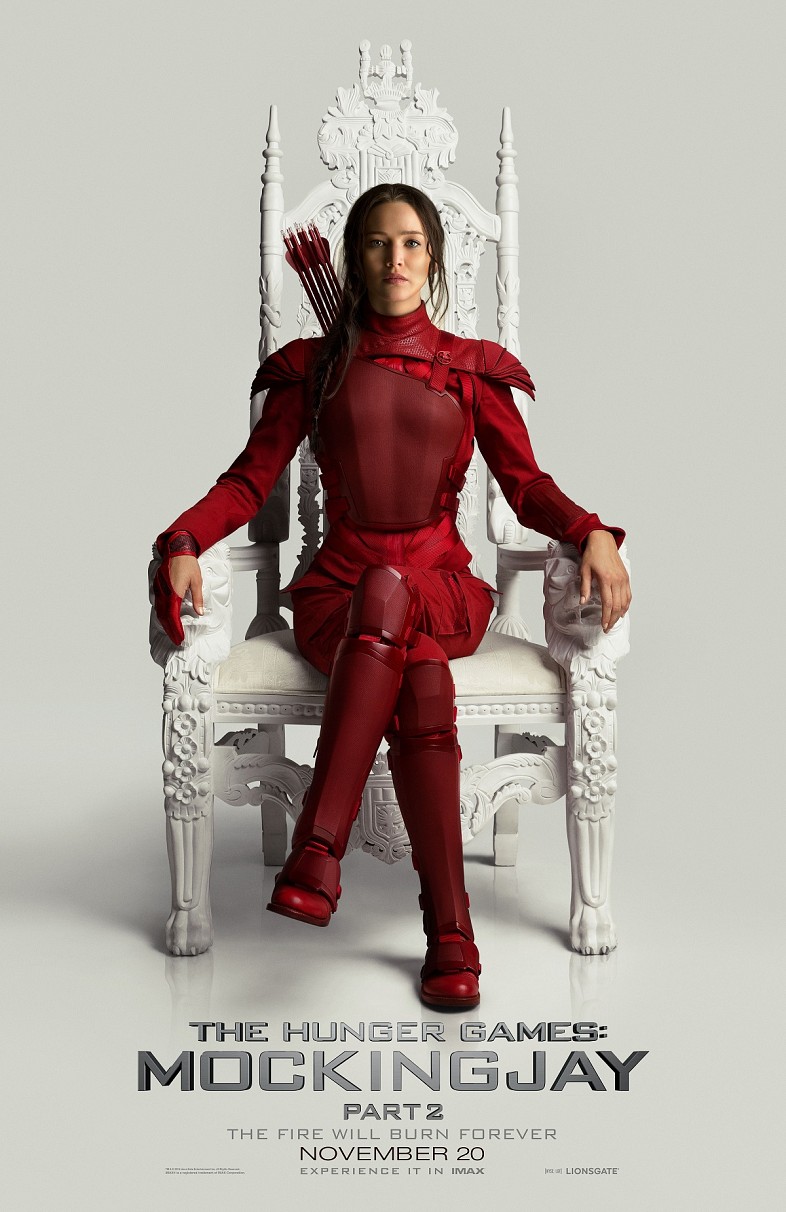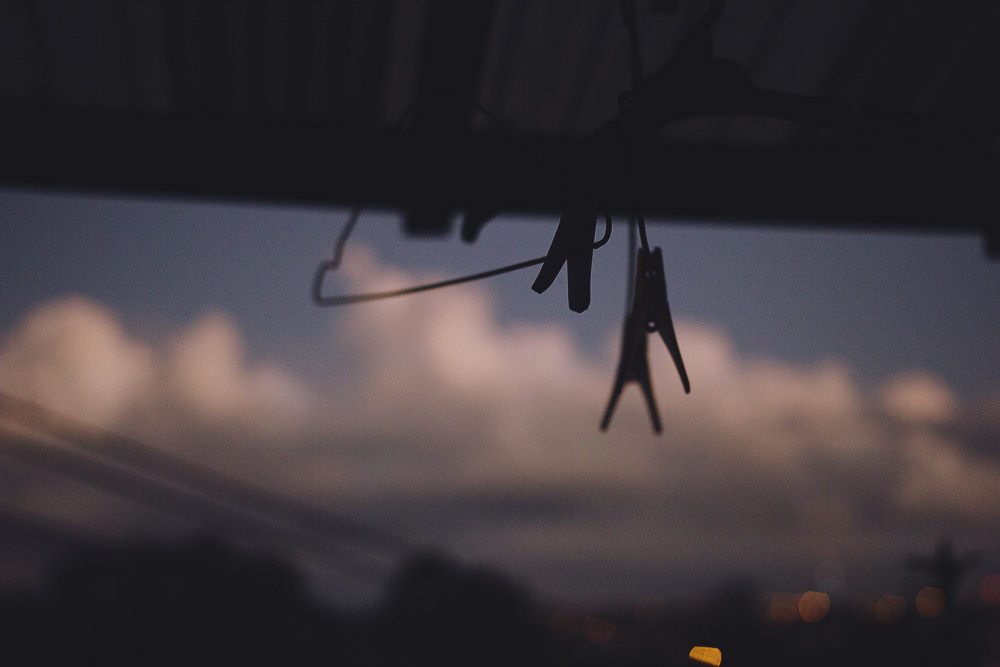
Panem Today, Panem Tomorrow, Panem Forever in Our World
Katniss raises her bow and lets loose an arrow, blowing a Capitol hovercraft out of the air. As it crashes into a second craft and they plummet to ground, the screen bursts into flames, and then: the Mockingjay logo over black. We watch this in the theater at the end of a trailer, Panem sees this at the end of a rebel propaganda short—a propo. The Hunger Games reflects a darker version of our own future, but our world reflects Panem right back.
Young Adult dystopian fiction is not a rare genre to find. Divergent, The Chemical Garden, Delirium, Uglies, Unwind, Chaos Walking, the list goes on. There are a vast array of reasons young adults connect with dystopian fiction. Give them a world they can see coming in their own future, a land destroyed by those before them, rules that tear away their agency, adults who would manipulate them, and yet give them the strength to grow, to change the narrative of their world for the better.
By wiping away the tedious normalcy of our lives now and exaggerating the things that already make life harder for everyone such as surveillance, media bias, body autonomy, and more, YA dystopian literature manages to not only distill issues in our present, but warn of future problems.
It’s no secret that The Hunger Games were inspired by the blurring of the visuals of young people in reality television and real war footage. The series represents a lot of our real world, and the themes brought up within the trilogy resonate with young adults right now. The surveillance of Panem, the othering of the poorer districts, the way the media warps our perceptions of the world. All of these things are very real, and though the Games themselves may not actually exist, the government and institutions that allow them to exist are near our own.
“I was lying in bed, and I was channel surfing between reality TV programs and actual war coverage. On one channel, there’s a group of young people competing for I don’t even know; and on the next, there’s a group of young people fighting in an actual war. I was really tired, and the lines between these stories started to blur in a very unsettling way.”
In Absolute Power Games, an essay written by Anthony Pavlik, Pavlik explores the trilogy through the lens of Umberto Eco’s notion of Ur-Fascism, pointing out that “Ur-Fascism seeks to win populace support through an appeal ‘against intruders’, taking advantage of people’s natural fear of the Other. The appeal of this focus is not to the masses as a whole … but rather to the middle classes, who fear lower social groups and thus live obsessed with plots … against their continued well-being.” This othering is experienced by the districts and the tributes so that the Capitol can continue its treatment of them, a deliberate move made by those in power.
If the Capitol citizens don’t see the districts as inferior and violent, the Games that keep the districts under control would not be able to continue existing. The Capitol’s over-extravagance is, in part, a very smart way to distance the citizens within its walls from the outlying districts. Effie expects barbarism from the tributes of District 12, having taken their ravenous hunger and therefore lack of manners as barbarism. She sees the tributes themselves as barbaric, rather than the Capitol that keeps them in such a state of starvation that manners are their lowest priority.
Consider this in the real world: in New Zealand, many white people are raised with white cultural ideals, while Maori are talked about in language that makes them seem more violent or uncultured, though that’s hardly the truth at all—it was, after all, white people who committed genocide and barbarically forced colonization upon the country.
Consider, also, how children in poverty (a very real issue in this country) arrive at school without shoes because their parents cannot afford them. Middle and upper-class ideals dictate that shoeless = uncultured, and though the bias is often subconscious, other children and adults will act upon their biases. Children of colour feel shame at their own cultural identity, poor children feel shame at their cheap lunches and their hand-me-down clothes.
The media, the education system, the way politicians spread xenophobia with the line, “They’ll take our jobs!” when talking about immigrants, it all contributes to the distancing of a privileged middle-class from those they fear will take the luxuries—or even the necessities—that they have.
These citizens often care about entertainment and indulgences more than politics or social issues, while those seen as “Other” watch the rich become richer, as they themselves struggle to make up the difference between a life on the streets and a damp, mouldy home, debt weighing heavily upon their shoulders.
They must dress up in the right costumes and learn to be “civilized” to begin to be viewed as anything close to equal, not unlike how Katniss must be stripped of her body hair and told to smile and laugh to be considered a child worth the time of sponsors. Her usual self, poor and more inclined to leather boots, would be considered less than human.
I’m hardly trying to claim New Zealand is a fascist state in the same way the Capitol clearly is, but as I said, the trilogy’s description of Panem isn’t just a dystopian future, but a look at the state of our own world. It is largely because of this reflection that the advertising campaigns for the films worked so well, and why the films resonated with so many.
Not only was Katniss a female lead with real strength (both literally and metaphorically), but she was also an underprivileged person struggling to present herself in the right way to even be heard. It’s a huge disservice to the character and the books to have cast her as white—and only looked at white actresses—considering her role and her description.
In Panem, the Capitol airs precisely planned clips of Katniss in her wedding dress, broken up by shots of whippings and executions. Once District 13 and the Rebels get a hold of her, they spread propos of Katniss helping the injured and destroying Capitol weapons.
The power to shape the narrative of the war is fought for over the airwaves. This battle is similar to how, in the real world, channels owned by people aligned with political parties frame stories to suit their own agenda, while social media allows other voices to fight back with their own words. In both our world and Panem, there is an understanding of the power media has to influence people’s perspectives on the world.
The advertising campaigns tapped into this understanding. The first film of the trilogy, The Hunger Games, sets up the idea of the Capitol existing as a ridiculous exaggeration of the rich and excessive. Unrealistic people, with their over-the-top fashion and lack of empathy for the tributes. However, what we see of that culture is not so different from observing our world’s fashion industry. Capitol Couture, an in-universe website that was initially only open to certain fans, launched in the January before the first film was released.
This website treats its audience as citizens of the Capitol, and much of the fashion shown among promotion for the films is from real designers and runways. In the lead-up to Catching Fire, couture portraits of the characters from the film were released, each as gorgeously shot and posed as the next. We see Katniss as the Capitol presents her at this time: a victor ready to be wed, holding a white rose representative of President Snow in her hand.
CoverGirl released a line of makeup inspired by the series, with looks drawn from each of the districts, in an eerie parallel to how the tributes are dressed up in costumes to represent their districts in a fashionable and palatable way. This makeup range was a way to capitalize on a series that gave us the very message that the people who saw the districts and tributes as fashion trends were the ones implicit in the murder of children. We, like the Capitol, became enraptured by Katniss’ appearance as much as her actions.
Lionsgate also teamed up with Subway in the lead-up to Catching Fire to release special “fiery” sandwiches—a move so horrifically ironic that it’s hard to believe someone thought it was a good idea. Not only were the aesthetics of the girl on fire appropriated for the sake of sales, they were used for bread, something that is almost as precious to Katniss and the starving districts as life itself. There’s likely not a more blind, Capitol-esque move that could have been made, using a girl often defined by her lack of food to sell that very product.
But then came Mockingjay, and all at once the real-world audience was placed in the role of the districts with a more self-away campaign. Billboards showing average people performing Katniss’ salute popped up around the world, along with photos of crowds joining in on the salute. Stickers of the Mockingjay symbol could be seen on the posts of streetlamps, or buildings—a less damaging version of the graffitied Mockingjays that can be seen within the Capitol itself in the final film. Teasers for the films came in the form of Capitol or Rebel propaganda, and the faction the audience is supposed to side with is easy to pick out: it’s the Rebels.

Yet, the media still fell into the mindset of the Capitol without realizing. The theme of the story was often trivialized for the sake of talking about Katniss’ (or Jennifer Lawrence’s) appearance, or discussing which of the boys Katniss would end up with. Katniss was talked about by hosts of radio or television shows, or even just fans, in much the same way that the Capitol presents her in the first two novels/films: in terms of her looks or her love life.
Even with the audience’s placement as Panem, the advertising played into problems with presenting women in the real world, as well as highlighting another theme of the series: that even the Rebels distort Katniss’ image to fit a semi-sexualized ideal. She may be wearing a sensible costume, but her face is heavily made-up and the posters and other advertising images are clearly photoshopped.

The Rebels go to great lengths to beautify Katniss so that she appeals to everyone, even doctoring her own memorial image because, put simply, feminized beauty sells. This links in perfectly with how women are used in advertising in the real world, because how Katniss was used to advertise the films in our world is exactly how she was used to sell violence and compliance in the series.
Really, in our world, she was also used to sell violence. We watch the Games with as much rapt attention as the Capitol, even growing to love other tributes and wishing for their survival. A reviewer for The Hollywood News even called Mockingjay Part 1 “the best Hunger Games yet …” and though he goes on to say that this is “despite, or maybe because, the “games” as we know them are now absent”, only the first part of the quote was included in TV spots for the film, which is a direct comparison to the way the Capitol citizens talk about each of the titular Games every year.
Why do many people prefer the second film? Maybe it’s the action-packed design of the Quarter Quell, or the stories of the victors forced to participate, or perhaps the desire to see how Katniss and Peeta’s relationship grows. These reasons for being enthralled by Catching Fire are not so different from many of the reasons Capitol citizens enjoy the Games.
Though we in the real world view the Games through a different contextual lens to those in-universe, one of the largest complaints about the first Mockingjay has been the lack of action, as if the Games themselves were what made the first two films so good. The films, however, do a good job of actively directing attention away from gratuitous violence and instead focus on the characters’ feelings, as if in direct response to the horrors the Capitol must gleefully broadcast.
Within the series, Rue’s four-note song becomes a symbol for the Rebellion as much as Katniss’ salute. These four notes can be heard throughout the films’ scores, as expected, but also within the Mockingjay Part 1 soundtrack curated by Lorde, a singer-songwriter from New Zealand who captures themes similar to those within The Hunger Games in her own music.
The choice to have Lorde herself curate the music for the soundtrack is an important one, as Lorde, like Katniss, performs femininity while using her distinctive voice and music to shape the narrative of her world. The four notes are haunting and ever-present, a symbol not just of Rebellion, but also of loss and of a world not so different from our own.
When we really look at the way the use of media distorts perceptions within the series, it’s not so hard to find real-world examples in our own communities that are often too similar. The reason the advertising for the films worked so effectively was because of the way both our world and Panem reflect each other.
We could act as citizens of Panem for the sake of a television spot, because we’re not so far from the people portrayed in the series, both Capitol and district. Though the story is fictional, the warnings and reflections seen within the novels and the films should be very seriously considered, because they tell of something that runs much deeper than we may realize.
Like my words? You can support me on Patreon!



